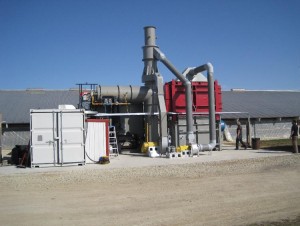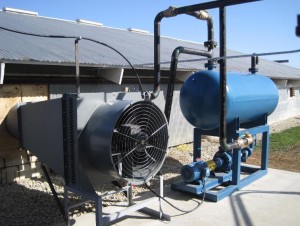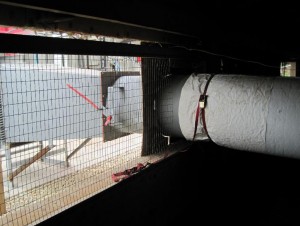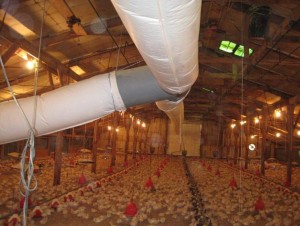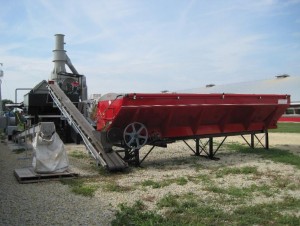Zimmerman Farm
This gasification project was designed to expand on the knowledge gained and data gathered from Coaltec’s Phase One Renewable Development Fund (RDF) project funded by Xcel Energy, and other projects. It is located at P & J Products, a turkey farm near Northfield Minnesota, run by John Zimmerman and his mother Karen. They raise approximately three million pounds of turkey annually that produce 2,100 tons of turkey litter (manure and shavings).
The gasification system was installed in early April 2009 and was initially running to eliminate manure and produce biochar. The modular-designed gasifier was assembled in seven hours, the electrics were completed on the third day, and the refractory was being cured by the fourth day. The system was running as designed with turkey litter as the fuel on the fifth day. A heat exchanger and hot oil system were installed in March of 2010 to provide heat to the turkey houses. The complete feed and ash removal system was installed in August of 2010.
The heat exchanger will replace the conventional method of using propane heaters to maintain the required temperatures in the houses. While the reduction in cost of propane can be easily measured, another of the project’s goals is to be able to quantify the improvement in animal health and growth. This increase is due to the superior environment supplied by the clean air from the gasification system versus the moisture-laden heat from the propane heaters.
The next stage of the project will be to evaluate the energy production and byproducts as viable sources of income. The measurement of the value of the system in each of these areas is critical to the determination of the success of the project and the commercial value of the system. A small turbine will later be added to produce electricity. There are various revenue streams or cost avoidance components to be quantified, including:
• Zeolite will be incorporated as a feed additive in a ration that is Generally Recognized As Safe by the FDA. Initial testing demonstrated a higher level of nitrogen retained in the litter when zeolite was added to the feed.
• Manure handling costs – the value of manure as a saleable product (which is the current status at P & J), or the cost associated with disposal (which is the situation in many regions) are determined by the cost to handle and transport the material. This cost must be quantified to determine the value of drying or gasifying the manure.
• Value of manure versus value of dried product as a fertilizer versus value of biochar/ash product after gasification.
• Cost and risk associated with mortality disposal versus including them in feed of gasifier.
• Cost avoidance of propane heat of turkey houses by replacement heat from the gasifier.
• Improved bird health, growth, and feed rate by improved environment due to clean dryer air from gasifier versus higher moisture irregular temperatures by propane heaters.
• Value of power generated – kWhrs produced and price.
• Amount of labor involved in operating system versus operating the houses with the current method.
• Value of carbon credits and potential value of biochar.
• Evaluation of different potential operating scenarios – use of corn stover and wood waste as fuel, value of manure as ash or as dried fertilizer, etc.
It is thought that the most beneficial economic value for the project will be from the sale of the pathogen-free biochar ash (see www.biochar-international.org for additional information on biochar and its many benefits, including carbon sequestration).
The turkey industry produces millions of tons of manure and litter annually. In some areas, Minnesota notably, turkey litter is considered to be beneficial when land applied; in others, nutrient loading of the soil from land application of litter is the grower’s biggest challenge. For instance, in the Chesapeake Bay Area, land application of manure is stringently regulated to prohibit nutrient loading; it can be very costly to dispose of the litter through transportation out of the area. Other regions of the country have fewer restrictions but encounter strong environmental pressure to reduce land application.
New upscale subdivisions are being built near the P & J Products site. There is some concern that in the future, land application of litter may not continue to be an accepted practice. As multi- generational turkey growers with a strong commitment to the industry, the Zimmerman’s are partnered with Coaltec in this gasification project in an effort to proactively assure that they remain good neighbors in their community.
Installation
The footprint for the entire system is 30-foot by 50-foot. A single phase 200-amp electrical service was required, as well as propane feed to the edge of the concrete pad. Components of the system include:
• Walking floor feed bin
• Hydraulic ram feed system
• Primary gasification unit – 36 square feet of reaction floor designed to process up to 12 tons per day of turkey litter – including walking floor bottom to remove ash from unit
• Refractory lined transition ducting from the gasifier to the oxidizer
• Thermal oxidizer
• Refractory lined stack
• Three air fans and various air ducting
• Hydraulic power pack
• Motor Control Center including PLC system and variable frequency drive controls on many components
• Roto-phase system to convert single phase power to 3-phase
• Step up transformer to increase voltage from 240 volts to 480 volts
• Remote access feature
• Ash auger to take material away from the gasifier
• Propane start up burner for the gasifier and modulating propane oxidizer burner to prevent smoking during start up and during operation in the event fuel quality is too poor to operate alone and stay within operating parameters
The energy application equipment includes:
• Refractory lined drop out box – attached between the bottom of the stack and the heat exchanger to remove particulate prior to hot oil tubes.
• Hot air to hot oil heat exchanger designed to convert between 2 and 3 MMBTU/hr. of energy to hot oil operating at up to 425 degrees.
• Induced draft fan
• Hood and ducting to connect the exhaust from the heat exchanger back into the stack
• Hot oil pump and tank
• Fan coil to receive hot oil and deliver hot air to turkey house – system is designed to provide 10,000 CFM to the house, and increase air temperature from -10 degrees to 90 degrees.
• Hot oil piping and controls to distribute and monitor oil flows.
• Air ducting from the fan coil to inside of the barn to supply the hot air into the barn.
• The fan supplying the air to the barn is a single phase unit and is totally separate from the gasification power system. This allows the fan to be used during warmer weather to supply cooling air to the barn without the gasification system operating.
This project is funded by the Xcel Energy Renewable Development Fund (RDF).
